Keeping an aquarium in your home is satisfying. But, if you are a mythical creature lover like me, you sure will love to own a fish that looks like a dragon.
The so-called dragon’s appearance varies according to the country, culture, and beliefs. Therefore, there are many different shapes of dragons out there.
While we don’t like to stick with only one shape, we have gathered all forms and listed some of the best fish that look similar to dragons.
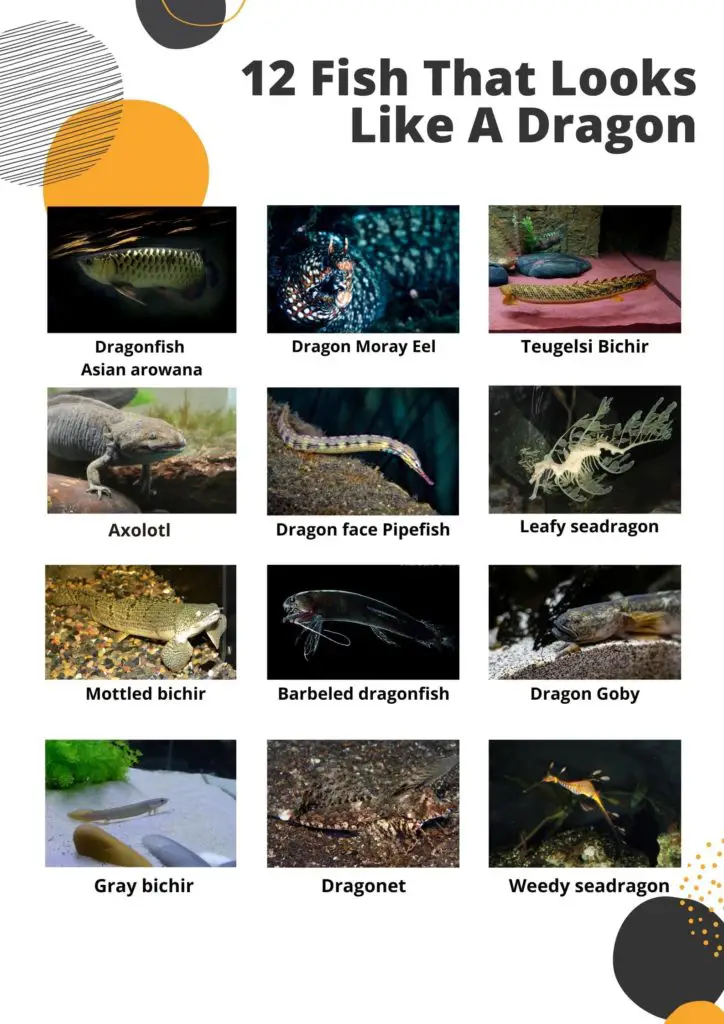
Asian Arowana
Jump To
- 1 Asian Arowana
- 2 Dragon Moray Eel (Enchelycore pardalis)
- 3 Teugelsi Bichir (Polypterus teugelsi)
- 4 Axolotl (Ambystoma mexicanum)
- 5 Dragon face Pipefish (Corythoichthys haematopterus)
- 6 Leafy seadragon
- 7 mottled bichir ( Polypterus weeksii )
- 8 barbeled dragonfish (Stomiidae)
- 9 Violet goby / Dragon Goby
- 10 Gray bichir / Senegal fish / Polypterus senegalus
- 11 Dragonet
- 12 Common seadragon/weedy seadragon
- 13 Conclusion
Known as one of the most popular and most expensive aquarium fish globally, Asian Arowana is a mesmerizing fish that looks like a dragon.
Native to Southeast Asia, Asian Arowana is famous as Asian bony tongue, dragonfish, and several other names.
These fish inhabit blackwater rivers, floodplains, swamps, ponds, and lakes of Southeast Asia in the wild. They are carnivores that feed on small fishes, insects, frogs, and crustaceans. So, they require a lot of meaty food in their diet.
Their size and growth rate are impressive enough to keep the fish eaters away. They are often kept in aquariums 60 inches or more in length since they can grow up to 3 feet long.
Asian Arowana lives peacefully with other fish as long as they are introduced at a young age. Their tank mates of Asian Arowana should be of the same size or bigger.
Although these fish are magnificent-looking fish that can be kept at aquariums, it is essential to note that Asian Arowana is completely prohibited from importing into the United States of America.
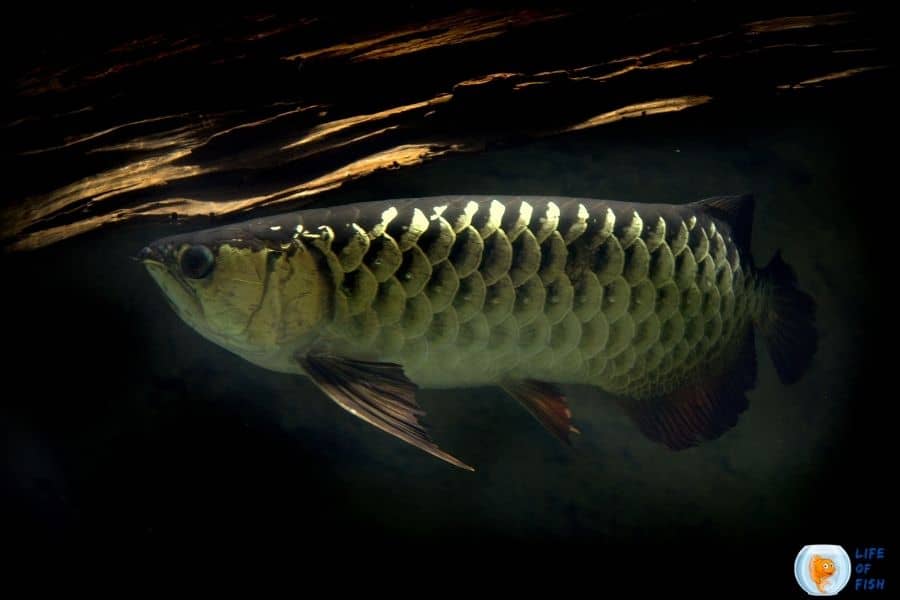
Dragon Moray Eel (Enchelycore pardalis)
Also known as Leopard Moray Eel or Tiger Moray Eel, Dragon Moray eel is a marine fish fish that looks like a dragon (dragon-like color morph).
They inhabit rocket and coral reefs in the Indo-Pacific ocean at depths ranging from 8 to 60 meters.
These creatures are widespread throughout Hawaiian, Line and Society Islands, Southern Korea, Northern and Southern Japan, and south to New Caledonia. Dragon Moray Eels often stay in schools containing their own species and similarly colored fish like Yellow Snapper.
Appearance-wise, these fish have a greyish-tan body with dark brown spots and yellowish stripes.
They have a lighter-colored belly which makes them look more similar to a dragon’s scales, but it is pretty hard to see when the light is dim in the ocean.
Dragon Moray Eels have narrow, curved jaws and vivid red stripes on the head. They get the dragon-like appearance from their elongated tubular nostrils. Being a carnivore species, these fish feed on fishes and small cephalopods with their enormous mouths at night time.
These fish reaches about 92cm in length, which is large enough not to fit in home aquaria. Therefore, only commercial aquariums keep these fish .
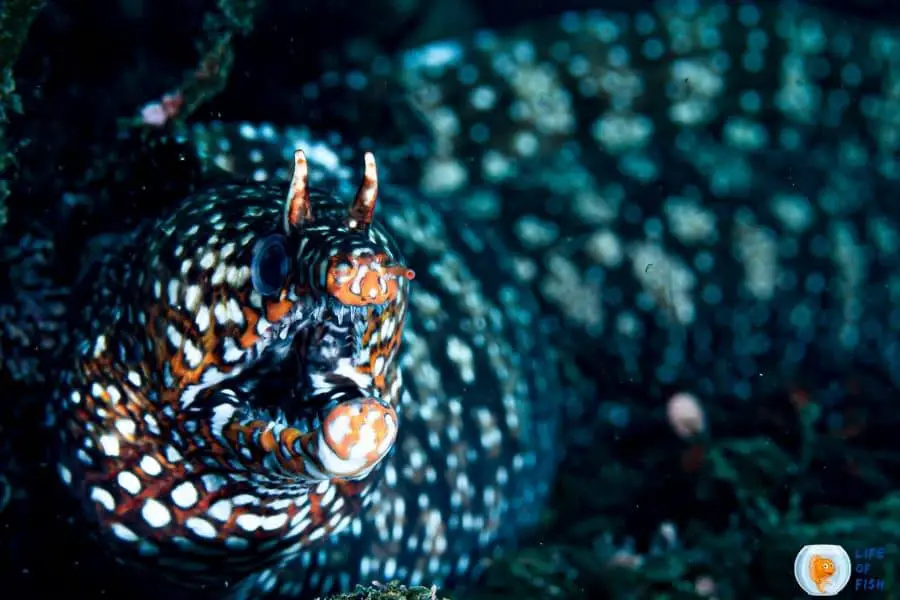
Teugelsi Bichir (Polypterus teugelsi)
Polypterus teugelsi is an endemic fish species to Cameroon’s Cross River drainage basin. It inhabits slow-moving rivers with a high level of dissolved oxygen and muddy bottom.
This species is one of the best freshwater aquarium inhabitants because of its peaceful and interesting behaviors.
Polypterus teugelsi has a brownish-olive-colored body with a lighter color underneath. It has a sharp, long dorsal fin along with a network of black markings on the dorsal surface, pelvic fins, and medial fins.
The elongated body of Polypterus teugelsi contributes to its dragon-like appearance.
Even though Polypterus teugelsi is not widespread, it does have a unique look due to the black markings on its body.
Polypterus teugelsi reaches about 30 inches in length with an average life span of over 20 years in captivity.
These fish use their smelling abilities to feed on aquatic invertebrates and small fishes in the wild. interestingly Polypterus teugelsi, can survive for some time without water if keep wet.
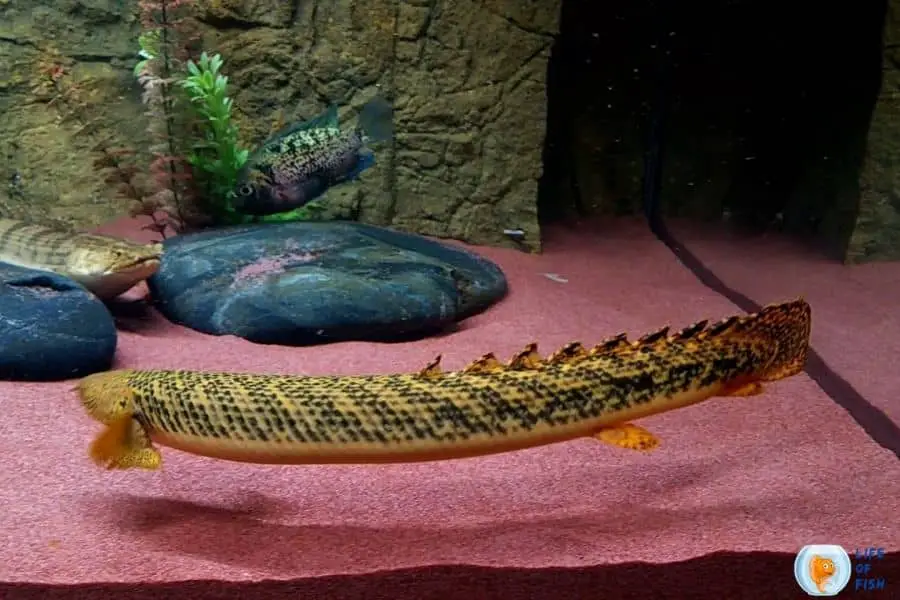
Axolotl (Ambystoma mexicanum)
The axolotl is actually a paedomorphic salamander species related to the tiger salamander. Unlike other amphibians, these species avoid taking to the land and remain aquatic and gilled.
They inhabit several lakes in Mexico city, such as Lake Xochimilco. In the wild, these creatures stay in dark water with high vegetation.
Since ancient times humans kept these fish as pets. Due to urbanization, Axolotl populations have declined rapidly and have been listed as critically endangered in the IUCN Red List.
The feathery gills and dorsal fins on their back describe this fish by giving them a dragon-like appearance.
Of course, they have slimy skins preferred by most people who keep them as pets. Axolotls have a wide variety of colors. They come in jet black, greyish, or pinkish hues.
The length of these creatures is about 9 inches on average.
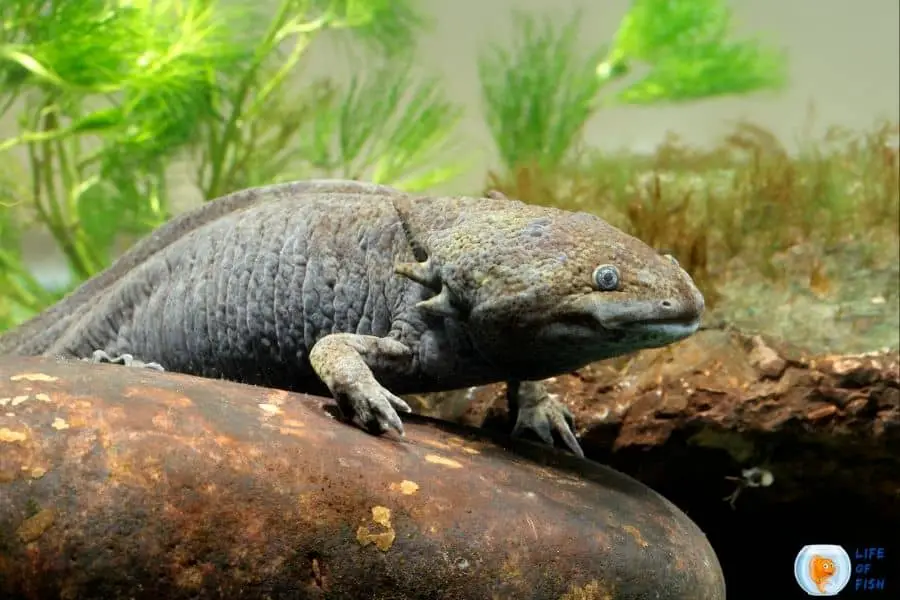
Dragon face Pipefish (Corythoichthys haematopterus)
Another fish that looks like a dragon is Dragon face pipefish( Reeftop Pipefish, Network Pipefish, Messmate Pipefish, and Banded Messmate Pipefish).
People name this fish as dragon face pipefish due to their dragon-like head, dorsal fins, and color patterns that change depending on their environment.
These creatures are widespread throughout the Indian Ocean to the Western Pacific ocean. They inhabit depths between 90cm to 30m on reef flats or rubble.
Dragon face Pipefish is a carnivore species feeding small benthic invertebrates like worms, crabs, and crustaceans.
These fish get about 7 inches long, small enough to fit in home aquaria. only experts can handle this fish These fish because they have unusual feeding requirements.
Dragon face pipefish can for camouflaging themselves by changing their colors and patterns. They can quickly change color from red to yellow, orange to white, or blue to black in a split second.
It is also a poor swimmer that relies on its body to slither over the substrate and live rocks, exactly like a snake’s movements! It may also use its tail as a last resort, relying on coral or rocks for further support.
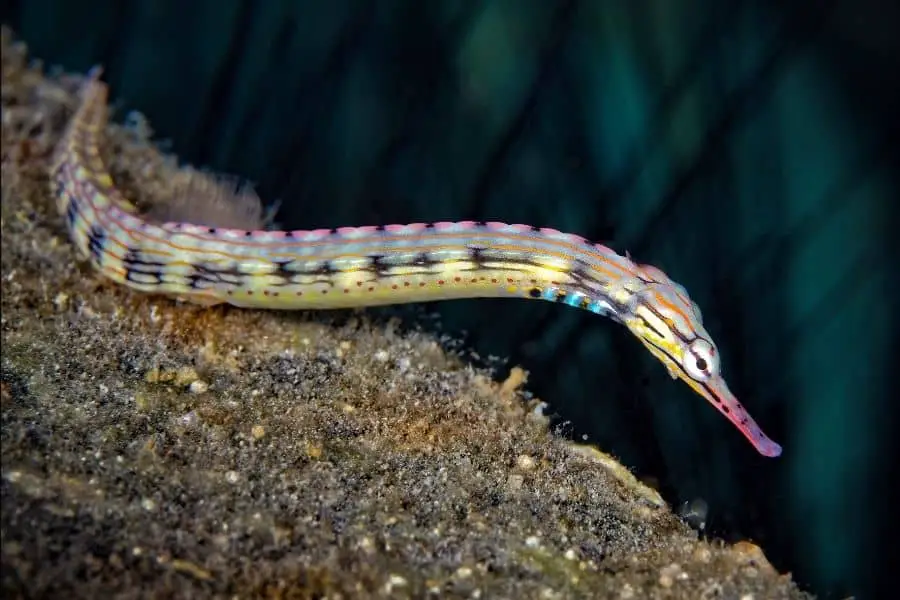
Leafy seadragon
The leafy seadragon is a marine fish that belongs to the Syngnathidae family.
These fish have long leaf-like protrusions coming from their body, and they use it as camouflage to blend with the surrounding vegetation.
The leafy seadragon prefers to live in the waters of south and west Australia. Leafy seadragon has one of the most unusual body shapes of all marine fish.
A leaf-like structure coming out from the head of this fish is actually its thickened and modified dorsal fin.
The scientific name for this species is Phycodurus eques, which refers to its resemblance to seahorses.
Leafy seadragons are the only member of the genus Phycodurus. Leafy seadragon can move these leaf-like appendages along the length of its body.
Also, it is a form of camouflage, as seen from many underwater photos.
The leafy seadragon is a fish species that is protected by law. Therefore is prohibited from keeping in captivity.
Still, these fish are available in the black market. If you want to own one, you need to be wealthy, patient, experienced and have a license to do so.
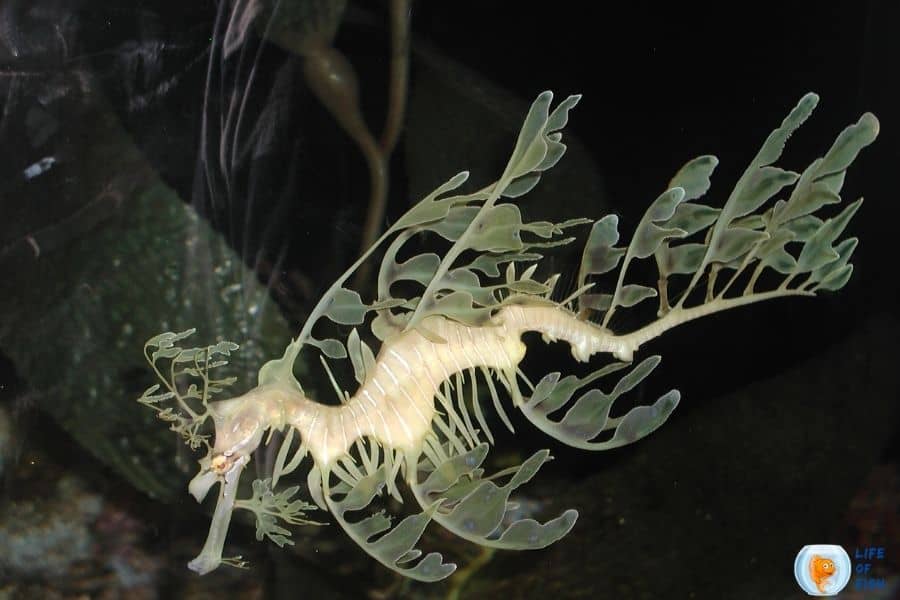
mottled bichir ( Polypterus weeksii )
Mottled bichir is their common name and It is a member of the Polypteridae family. Central basin of the Congo River is there native habitat.
The body of a Polypterus weeksii has a camouflage color pattern with a yellowish-brown body and dark brown/black spots that look like leaves.
Due to These unusual feeding requirements of this fish only found in the care of expert aquarists . When Polypterus weeksii was first discovered, it was thought to be an entirely new type of seadragon.
However, a close look at its dorsal fin and the lack of pelvic fins clearly show that it is unrelated to the seadragon.
Mottled bichirs are predators who have sharp teeth and eat just about any fish they get in their largemouths.
They are feed on fish, lobster tails, crabs, mussels, and shrimps. But they are mild temperament species.
These creatures are not that hard to take care of in-home aquariums. The only requirement is an aquarium that can hold a 54cm long mottled bichir.
However, many aquarists avoid keeping these fish in home aquariums due to their size.
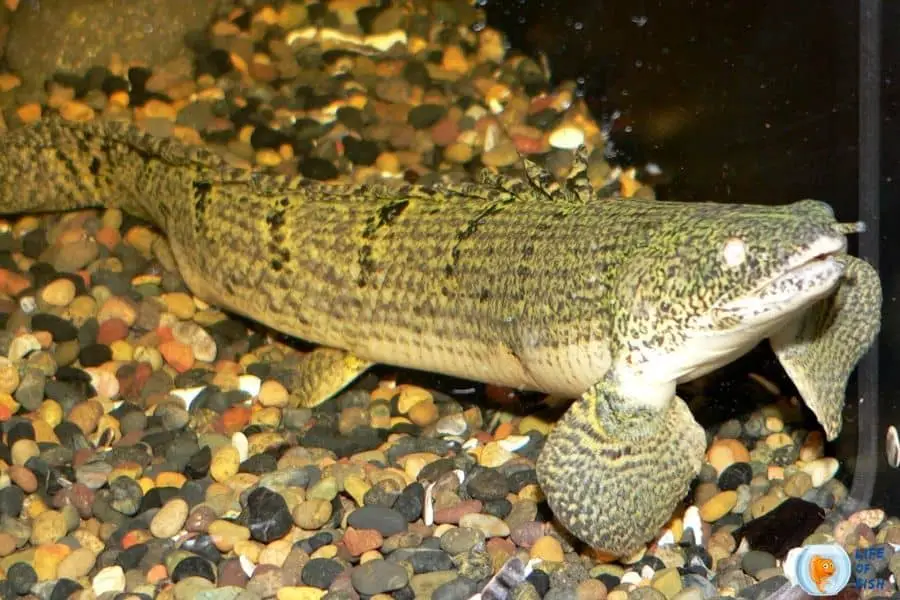
barbeled dragonfish (Stomiidae)
Stomiidae or barbeled dragonfish is a fascinating ray-finned fish family that lives in the deep sea.
These fish are relatively small with up to 26cm long body but they are apex predators because of their razor-sharp teeth and the head that can help their jaw to open more than 100 degrees. They can capture and chew on fish that are 50% greater than their average size.
These fish are black, dark brown, deep red, bluish, or purple, with light green bioluminescence glowing from their head region.
Their skin is covered with large numbers of light-producing organelles known as photophores.
Barbeled dragonfish feed on fish, shrimps, and other invertebrates that lives in the deep sea. They use their light-producing cells to blind their prey.
Barbeled dragonfish are not suitable for home aquariums because they have increased requirements compared to other fish. They require a huge tank, a varied diet, and an experienced aquarist.
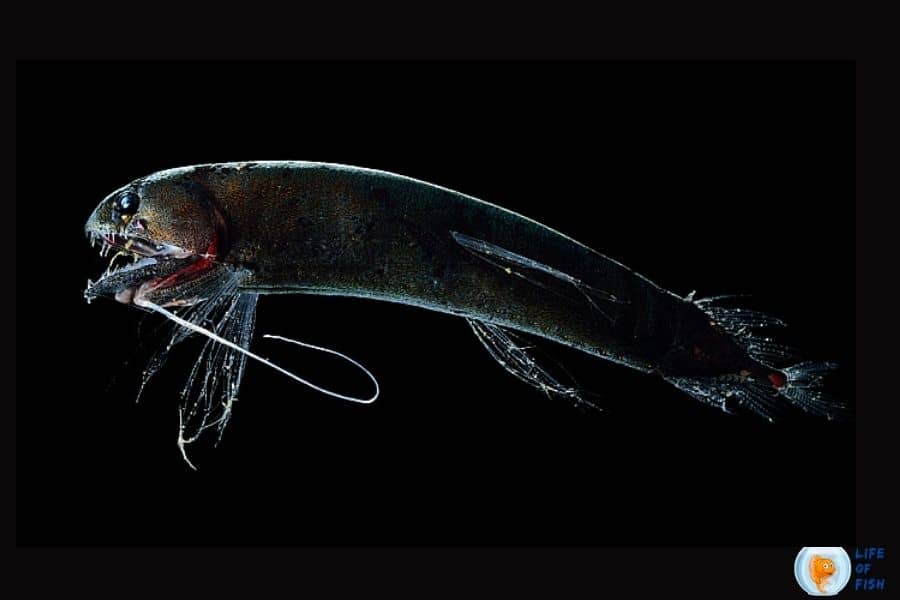
Violet goby / Dragon Goby
Violet goby is a widespread Goby species found in fresh, marine, brackish, and even hypersaline habitats.
The violet goby can be identified by its eel-like, dark violet body with yellow blotches all over the body and a long dark stripe that stretches from the head to the caudal peduncle.
Violet gobies can grow up to 24 inches in the wild but have a stunted growth of below 15 inches in captivity.
Violet gobies are not fiery looking like the Stormiidae and have an adorable look that everyone likes.
These fish can be found on the Nothern Atlantic coast, in South America, especially in South Carolina, and all along to northern Brazil.
Although many aquarists love violet gobies, you may not be able to find one easily from the aquarium market.
If you want to keep violet goby in your aquarium, you will have to catch them from the wild. However, keep in mind that violet gobies require brackish water and a large tank to survive in captivity.

Gray bichir / Senegal fish / Polypterus senegalus
Polypterus senegalus is a primitive and prehistoric fish that has a lungfish-like appearance.
It is also known as Gray Bichir, Senegal fish, Dinasaur bichir, dinosaur eel, and sometimes dragon fish in the pet trade.
Despite its name, this fish is neither an eel nor a dinosaur. Hailing from African waters, these fish are widespread worldwide due to their popularity as pet fish.
Gray bichir is an elongated fish with large pectoral fins on both sides of its body and a dorsal fin that runs from head to tail.
They possess a long and vaguely cylindrical body, usually grey or beige in color with rhomboid-shaped, multilayer scales, making them look like dragons.
Sometimes, the body consists of white, pink, or blue shades or darker blotches or spots. Gray bichirs can grow up to 14 inches in length. The females are usually larger than the males.
Because of its poor eyesight, the Gray Bichir relies on its sense of smell while hunting for food. The mouth of Gray Bichir is large, with two pairs of sharp teeth located on both jaws, creating a powerful bite to tear large chunks out of food.
Gray bichirs are carnivores that eat almost everything they can catch, including fish, shrimp, crab, snails, and even other smaller fishes.
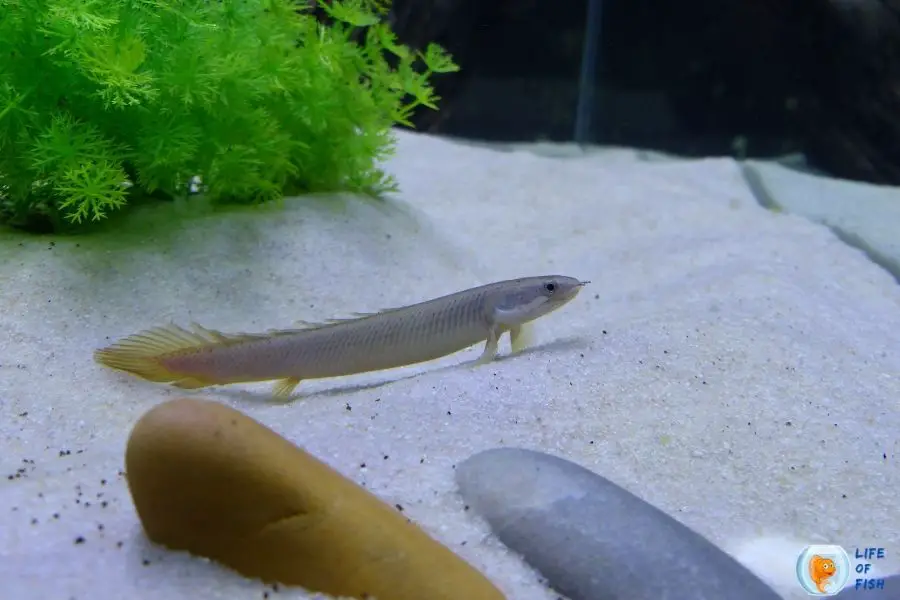
Dragonet
Dragonets are percomorph marine fish that live in the tropical waters in the Western Indo-Pacific ocean.
There are about 139 species that belong to 19 genera, and all of them are smaller in size. The smallest Dragonet species ( Saint Helena dragonet) reaches only about 2cm, while the largest dragonet species (longtail dragonet) reaches about 30 cm long.
Although dragonets are on the smaller side, they are popular because of their dragon-like appearance.
Dragonets are scaleless fish, but they have tough skin to protect their body from predators. They are often found in shallow lagoons full of staghorn corals, gorgonians, soft corals, and sponges.
These fishes have a small mouth with protrusible jaws on the lower first jaw. They have a pair of barbells at the corners of their mouth to detect food and locate prey. Dragonets are solitary fish, but they may school under certain conditions.
Dragonets eat a wide variety of food, including small crustaceans, mollusks, polychaete worms, and echinoderms.
They are generally not recommended to be kept in the aquarium because of their small size and specific needs for survival.
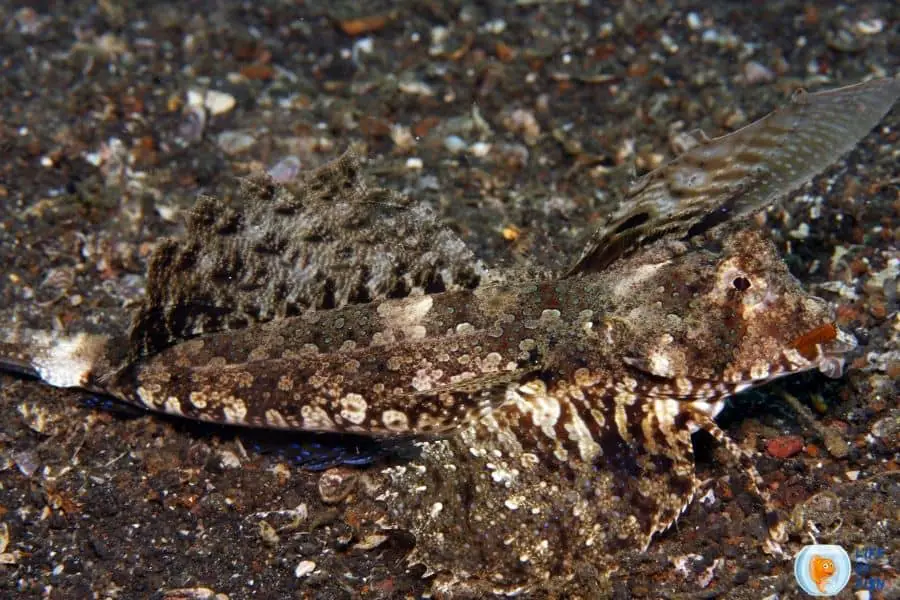
Common seadragon/weedy seadragon
The common seadragon, also known as weedy seadragon, is a marine fish related to seahorses. It is native to the waters of southern and western Australia.
The common seadragon has a slender, elongated body with tiny scales that appear to be embedded in the skin. It has a prehensile tail that can grasp objects like seahorses.
Its body color ranges from pink to red with yellow and purple patches. The common seadragon can grow up to 1.8 feet (45 cm) in length and has a lifespan of about 9 years.
It has leaf-like appendages that are not used for swimming which gives it an appearance similar to a piece of seaweed drifting in the ocean.
Swimming is often done by moving its dorsal fin up and down, so it looks like a jousting knight of the sea. Common seadragon can be found in waters up to 165 feet (50 meters) deep and feeding on small crustaceans and other zooplankton.
The common seadragon is rarely seen in the wild and often kept in aquariums because of its unique appearance.
It can be kept with other seadragons or similar-looking fishes such as the leafy and weedy seadragons.
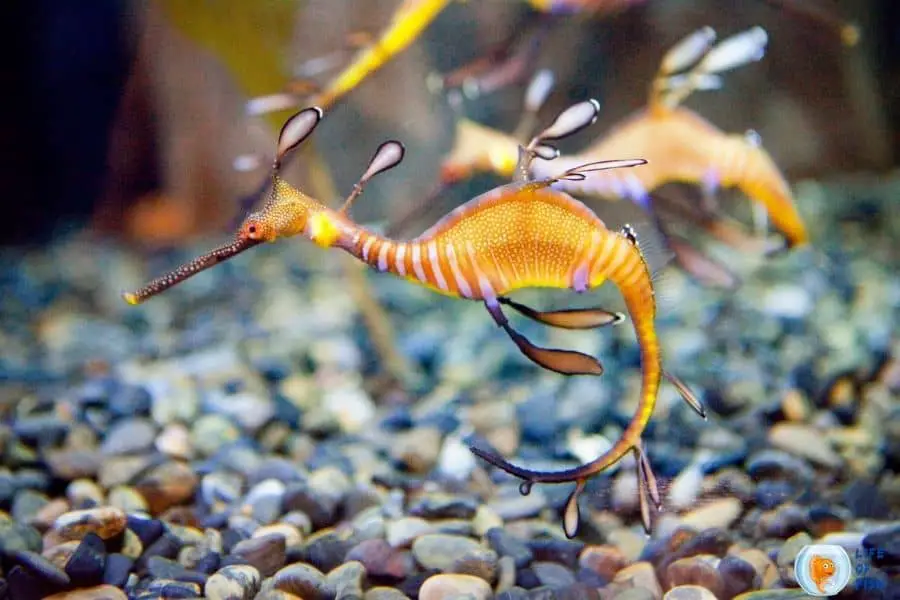
Conclusion
These 12 fish species closely resemble dragons more than other animals. They have different colors, shapes, sizes, and patterns, but they all look amazingly similar to mythical creatures.
Some of these fish are popular for being kept as pets, while others are kept in public aquariums to educate people about marine life.
If you plan to keep a fish that looks like a dragon, make sure to research their specific needs and make the best out of it for both you and your fish.
Read Next : Auratus Cichlid | Most Terrorizing Fish I Purchase |
